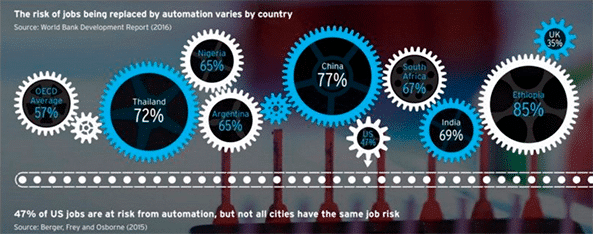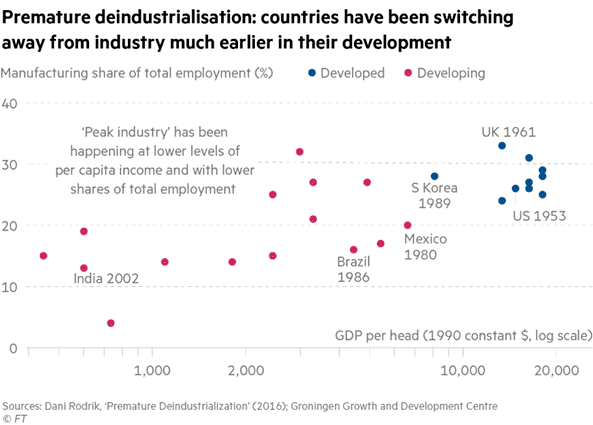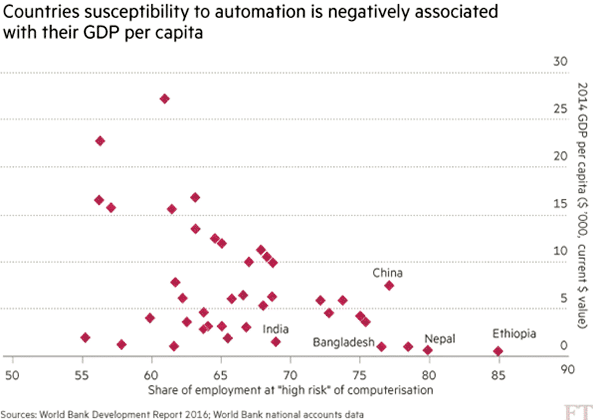Theme
Technological justice can play an important role within the international system in resolving global challenges and creating a smart and more equal world society.
Summary
Technological and scientific developments are generating huge opportunities for tackling societal challenges. However, the benefits of technology and innovation are unequally distributed, and they tend to cause economic and political disruptions in our societies that widen inequalities. The authors propose adopting the concept of ‘technological justice’ within our societies as a new paradigm for the international system to reconcile technological advances with the societal challenges facing our global society, especially poverty and sustainability. This paper proposes a number of policies and measures by which the G-20 could take on a central role in pushing this major contribution onto the global agenda.
Analysis
The concept of technological justice
Major changes are currently underway and, in the years ahead, more change will come from technological and scientific developments. Technology –digital, mechanical and biological (the importance of the latter has grown with the emergence of gene editing)– is creating huge opportunities. The role that the new connectivity (via mobile phones) is currently playing in Africa’s development is one example. But technology can also generate major disruptions. It could also lead to greater inequalities –of a new type– within and between societies. If gaps emerge in access to technology –crucial for development and essential for participation in global value chains–, the technology itself and associated opportunities will be highly unequal in their effects.
As with the two faces of Janus, there is a dialectic relationship between technology and society: technology is both part of the solution to societal challenges and part of the problem, and this deepens social inequalities.
The concept of technological justice can reconcile these two faces, connecting technology, a critical factor in human development, with our aspirations for social justice and greater equality between economies.
The Sustainable Development Goals (SDG) Agenda mentions innovation and technology (Goal 9), but the Agenda does not link it to justice and equality (Goal 10). They should, however, be connected: in that endeavour, the G20 could have a central role.
We propose to develop this concept of ‘technological justice’, along with relevant policies. Typically, the concept of technological justice has been employed to refer to domestic inequalities and internal gaps within societies. We intend to inject the concept with the international dimension and use it to reconcile technological advances and aspirations with greater social justice and equality between societies. We could define it as ‘a situation in which technologies don’t create new social gaps and deficits, but on the contrary lead to a smart world society, especially as far as the solution of major challenges like poverty and sustainability is concerned’. Technological justice refers not only to digitalisation, automation and 3D printing, but to all sorts of technologies, including biotechnology.
‘The concept of technological justice requires a rethinking of how –both in the developing and the developed world– to encourage and nurture technological innovation that has social value and is environmentally sustainable’.1
During the last decade, the European Commission introduced the concept of ‘Responsible Research’, an approach to developing not only science-based technological solutions for some of our major societal challenges, but also to harness the power of existing knowledge to contribute to social justice. This constitutes both an ethical constraint on technological improvement and an inevitable condition for social acceptance and democratic legitimacy.
The idea of technological justice must go hand in hand with the idea of technological convergence between countries.
The Hamburg G20 Final Communiqué aimed to ‘bridge digital divides along multiple dimensions, including income, age, geography and gender’, and to ‘ensure that all our citizens are digitally connected by 2025’, emphasising in particular the related ‘infrastructure development in low-income countries in that regard’.
Technological justice could be part of the G20 goals; it is closely related to the 2030 Agenda to which the G20 aspires to connect. Even if there is no specific goal for it, as we say, it could connect goals 9 and 10 of the SDGs. The G20 could promote policies that could contribute to the setting of this connection.
To cope with the greater impact of automation on developing economies is the challenge
An UNCTAD study comes to the conclusion that automation –one of the major effects of technological progress– could destroy two thirds of the jobs in the developing world.2 But in its report on global investment, UNCTAD recommends that developing countries invest in digital technologies, on the assumption that to fail to do so would leave them further behind.3 According to the Robotlution report from Intal-IDB,4 automation could affect 1.1 billion people in the world. With respect to one key region, the report claims that Latin America is the third region (after China and ASEAN) to lose the most from automation. For example, in Argentina automation may affect 71% of people educated only to the primary or secondary school levels, and ‘only’ 40% of university graduates.
Automation could lead the developing world into a low or middle-income trap, and even, according to economist Dani Rodrik, to a ‘premature de-industrialisation’ in many of those countries, in favour of the developed world, particularly of its most technologically advanced countries.5
Figure 1. The risk of jobs being replaced by automation varies by country

These forecasts coincide with others –from Frey, Holmes & Osborne– in that the developing world will lose its comparative advantages as jobs are replaced by robots and 3D printing.6 This is still not fully the case because of the abundance of cheap labour and because automation is still expensive in many aspects beyond the automotive and electronics sectors. But even if it arrives later, automation and 3D printing will encourage companies to bring their manufacturing back home, and even more so in an environment of greater trade protectionism.
Brazil and India, for instance, have seen their share of manufacturing employment peak at no more than 15% at a time when GDP per capita was less than US$5,000 in Brazil and US$1,000 in India; yet some 69% of jobs in India and 77% in China are at ‘high risk’ of automation, along with more than 47% in the US and 57% on average across the OECD.
The International Labour Organization (ILO) foresees the need to generate 40 million jobs a year just to cope with population growth, and more than 300 million a year to achieve the UN Sustainable Development Goals by 2030. These goals might be threatened by the impact of digitalisation and automation. According to recent studies by the OECD, Africa needs to create around 30 million jobs a year between now and 2025 to keep up with the number of youth streaming into the job market. If the Internet continues to grow at the same pace as mobile telephony in Africa, 20 million to 30 million jobs could be created per year in the digital economy sector.7 However, automation could impact in the opposite way.
Figure 2. Premature deindustrialisation: countries have been switching away from industry much earlier in their development

Developing economies could suffer from technological backwardness, also derived from a brain drain towards the developed world. These two factors together could produce a gap difficult to fill. ‘But, in the longer run, it will bring benefits for the entire world by making smart products that help to address challenges that affect us all’, according to Van Agtmael & Bakker.
Research by the United Nations Industrial Development Organization (UNIDO) confirms that the share of manufacturing and manufacturing jobs in the average developing economy has fallen.8 But for developing economies as a whole, the share of manufacturing and manufacturing jobs is at a record high level. Nonetheless, this statistical reality is caused mainly by China. Without China, the problem stands. And China will be greatly affected by technological automation, a trend which it is indeed fostering with strategies like ‘Made in China 2025’.9
According to UNIDO’s study, ‘premature deindustrialization or non-industrialization has recently been increasingly noticeable in developing countries with a lower share of manufacturing in GDP at their peak, which they reached at a much lower level of income than the early industrializers’. While the debate on whether services can become a new growth-enhancing sector continues, research indicates that premature deindustrialisation is prevalent in developing countries and that ‘manufacturing no longer plays the role of the engine of growth in developing countries’. Yet even UNIDO raises some doubts about this argument, especially with respect to China.
Figure 3.Countries’ susceptibility to automation is negatively associated with their GDP per capita

The size of cities also matters, as far as technology is concerned.13 Small cities in the developed world are at risk of job displacement from automation. This conclusion, based on the case of the US, could also apply to the developing world, particularly in Africa, where societies are experiencing simultaneous industrial and urban revolutions. The growth in the size of the cities favours ‘technologisation’.
It could also favour the important task of insertion into the global value chains of the economy. This requires productive and export capacity to be expanded by improving national supply networks, human capital and available infrastructures.14 Current trends see direct investment from multinationals shifting to sectors with greater technological content and added value, and which require greater training of the workforce. Most of these companies do not merely seek to minimise labour costs at any price, but rather weigh the differences between training, productivity and wages, and in general pay their employees’ salaries well above those of other workers in the country. Industrial policy should not focus on identifying ‘national champions’, but rather on coordinating a series of integrated or chained investments that allow for the development of the local productive base.
According to the McKinsey Global Institute analysis of the ‘haves and have-mores’ in digital America, industries that adopt more technology quickly are more profitable. Sectors that create the most jobs –such as retail, education and government– are slower than the tech and financial sectors in terms of incorporating digital technology into their business models. If that applies to the US, then even more so within the context of developing economies.
In November 2017 the EU (the Council of the EU and European Commission) adopted a framework for D4D (Digital4Development) as part of its development policy (with an immediate focus on Africa) that could inspire actions at the global level. The aim is to develop digital infrastructure, promote e-governance and digital skills, strengthen the digital economy and foster start-up ecosystems including funding opportunities for micro, small and medium sized enterprises. Even though the private sector plays a critical role in achieving those aims, the EU has created an investment window for such purposes within the European Fund for Sustainable Development.
Policies to facilitate global technological convergence
As explained above, the SDGs include innovation and technology (goal 9) but do not connect them with justice and equality (goal 10). The Hamburg G20 Summit agreed to:15
- Promote digital literacy and digital skills in all forms of education and life-long learning.
- Push for the role of SMEs in this area.
- Promote effective cooperation of all stakeholders and encourage the development and use of market- and industry-led international standards for digitalised production, products and services that are based on the principles of openness, transparency and consensus, so that standards do not act as barriers to trade, competition or innovation.
Develop a societal concept
Japan, its government and the Keidanren organisation.16 are developing the concept of a Society 5.0, in which everyone would benefit from a super-intelligent society. A concept of a Global Society 5.0 should be developed for a super-smart global society. Solving social issues will ‘create future’.
Public policies at multiple levels
What would the consequences be –in terms of public policies– of advancing technological justice? (1) Social policies: to raise efficiency and inclusiveness in the welfare system through technology; (2) fiscal policies: to give incentives to technologies that, while not profitable in competitive market conditions, can provide redistributive benefits (education, health, work, etc.); (3) development aid policies that incorporate technology; and (4) R&D policies. Below is a list of potentially useful public policy directions to consider.
Innovation and technological redistribution:
- There is a need for a renewed focus on reform of national and international innovation systems and R&D policies, in an attempt to create a new consensus on how public-private partnerships can contribute to a more open and sustainable use of technology.
- More ‘open source’ access for technologies should be sought. There are still countries in the developing world that lack proper access to fundamental innovations such as medicines, electricity, information and communication technologies (ICTs), biotech and so on. It is essential to assure an open diffusion of knowledge, innovations and technologies in the design of development policies.
- Development policies should support redistributive systems and incentives for successful application of new technologies.
- Competition must be ensured to push for innovation.
- Research and development should aspire to cover the basic needs of humanity.
- More attention should be paid to possible major advances (like CRISPR) in biotechnology and genetic manipulation (which will both fight diseases and generate new inequalities).
- Legal frameworks should be promoted to enable innovation and the use of new technologies.
Education:
- Improve the education of the left-behind countries through global schemes (a global technological Erasmus?). Promote STEM studies and critical thinking in developing counties and expose their school children at an early age to digital education. This could be a way to link technological justice to SGG 4 on Education.
- Invest in education to ‘upskill’ and ‘reskill’ the workforces to benefit from the rise of robots, rather than being a victim of this trend.
- Implement the Africa 2.0 Manifesto (endorsed by 43 Ministers of Education) that embraces creative and innovative approaches to education.17
- However, education cannot be the solution to everything; job creation policies must also be pursued.
Technology for local consumption and empowerment of women:
- Produce technology for local consumption in developing countries (especially in Africa), and where necessary in cooperation with the more developed economies. There is here another link to the general approach of the SDGs to sustainable economic growth.
- Design policies for the technological empowerment of women (a T20 Policy Brief was released on this subject).18
Energy:
- Close the energy deficit through exploitation of on-grid, off-grid and mini-grid technologies.
Taxing rents:
- Proposals like taxes on robots or universal basic income are not workable at a global level. Taxing rents seems more appropriate.
- Study new ways of securing tax incomes.
Protect people:
- The aim should be ‘to protect people, not jobs’ (Emmanuel Macron). All those policies with a holistic approach would constitute an agenda for technological justice.
Timeframe and funding of policies
As we have argued, technological Justice should be linked to the SDG Agenda. As a result, the timeframe for proposals should coincide with the 2030 horizon. One of the most significant challenges is to overcome constraints on knowledge transfer and technology applications for sustainable goals or socio-economic challenges. For that reason, strategic funding instruments for the diffusion of technology improvements are essential. Such developments are even more constrained without international cooperation –no longer just an option but rather an imperative for achieving technology and innovation policy goals–.
Funding instruments should be based on public-private partnerships with different purposes and clustered by their priorities in strategic sectors for achieving justice goals, especially for those areas with an impact on welfare (Health and Education) or with a significant weight in production patterns (Industry, Agriculture, Transport and Energy).
Investments in technology and research infrastructure with effects on capacity building should be supported by international cooperation to foster developments in specific fields (material science, ICT, nanotechnology) or in a specific area of generic research (bio-technology, computational genomics). Another alternative is to develop national infrastructures open to an international research area. An example of this framework is the Barcelona Supercomputing Centre, an infrastructure open to European researchers through a Partnership for Advanced Computing in Europe (PRACE).
Joint ventures between public agencies, technology centres and industries should contribute to address societal priorities promoting specific technologies. The public sector could act as the risk taker or entrepreneurial innovator as it has been with respect to the recent developments in ICT (Internet, GPS, mobile, etc). A scheme like the EU’s D4D program should also be tried at a more global level.
Finally, funding should target support for entities involved in technology transfer (incubators, start-ups, university technology centres, etc), reducing the constraints on access to the elicitation of knowledge and technology diffusion. Again, clusterisation and smart specialisation are necessary for an efficient distribution of talent and resources.
Conclusions: In the current age of rapid scientific developments, it is necessary to introduce the concept of ‘technological justice’. Such a notion aims to reduce social disruptions and inequality within states as well as between developed and developing countries. For the latter, digitalisation and, especially, automation are challenges that must be faced if developing countries are to avoid premature de-industrialisation, expulsion from global value chains of the world economy, and the serious damage to their growth paths that would result.
In this respect, to foster a technological convergence among countries, and to aspire to a smart world society, the G-20 should have a central role connecting the 2030 SDG goals which include innovation, technology, justice and equality. More specifically, the policies to apply in developing countries must pursue aims such as the open diffusion of knowledge, improving digital education, producing innovations for local consumption, the technological empowerment of women, and the reduction of their energy deficits. Implementing such policies in a context of international cooperation would make public-private partnerships a key instrument for funding infrastructures, joint ventures, incubators, start-ups and any other of entity with a significant capacity for technology transfer.
Andrés Ortega Klein
Senior Research Fellow, Elcano Royal Institute | @andresortegak
Francisco Andrés
Projects Office Coordinator, Elcano Royal Institute | @FranAndresP
Additional References
Baldwyn, Richard (2016), The Great Convergence. Information Technology and the New Globalization, The Belknap Press of Harvard University Press, Cambridge, Massachussets.
Herweijer, Celine, Benjamin Combes, Leo Johnson, Rob McCargow, Sahil Bhardwaj & Bridget Jackson (2017), ‘Enabling a sustainable Fourth Industrial Revolution: how G20 countries can create the conditions for emerging technologies to benefit people and the planet’, T20 Policy Brief.
ILO (2017), World Employment and Social Outlook: Trends 2017.
MOFA (2017), ‘Japan’s Growth Strategy’.
Obado, Grace (2017), Conference, Madrid, 27/IV//2017.
Ortega, Andrés (2016), La imparable marcha de los robots, Alianza Editorial, Madrid.
Ortega, Andrés (2017), ‘Justicia tecnológica’, Eldiario.es.
Practical Justice (2016), ‘Introducing Technology Justice: A New Paradigm for the SDGs’.
Sandu, Martin (2017), ‘Technological Justice’, Financial Times.
Stacey, Kiran, & Anna Nicolaou (2017), ‘Stitched up by robots: the threat to emerging economies’, Financial Times, 18/VII/2017.
Van Agtmael, A. & F. Bakker (2016), The Smartest Places on Earth: Why Rustbelts Are the Emerging Hotspots of Global Innovation, PublicAffairs, New York.
1 Simon Trace (2102), ‘How Technological Justice Can Fight Global Poverty’.
2 UNCTAD (2016), ‘Robots and industrialization in developing countries’, Policy Brief.
3 UNCTAD (2017), ‘World Investment Report 2017. Investment and the Digital Economy’.
2 IADB (2018), ‘Robot-lución: el futuro del trabajo en la integración 4.0 de América Latina’.
5 Dani Rodrik (2015), ‘Premature deindustrialization’, NBER Working Paper nr 20935, February.
6 Carl Benedikt Frey, Craig Holmes, Michael Osborne et.al. (2016), ‘Technology at work v2.0’, Citi/Oxford Martin School.
7 McKinsey Global Institute (2013), Lions go digital report.
8 United Nations Industrial Development Organization (UNIDO) (2016), ‘The importance of manufacturing in economic development: has this changed?’, Inclusive and Sustainable Industrial Development Working Paper Series, WP 1/2016.
9 State Council, China (2015), ‘Made in China 2025’.
10 Richard Dobbs, James Manyika & Jonathan Woetzel (2015), The Four Global Forces Breaking all the Trends, McKinsey Global Institute.
11 Grace Obado (2017), ‘Structural transformation and digitalization of African economies’, presented to ‘Africa in the perspective of G20’, Conference, Madrid, 27th April 2017.
12 Manyika, James, Sree Ramaswamy, Somesh Khanna, Hugo Sarrazin, Gary Pinkus, Guru Sethupathy & Andrew Yaffe (2015), ‘Digital America: a tale of the haves and have-mores’, McKinsey Global Institute.
13 Morgan R. Frank, Lijun Sun, Manuel Cebrian, HyeJin Youn & Iyad Rahwan (2017), ‘Small cities at risk of job displacement from automation’, 18/V/2017.
14 Theodore W. Theodore (2014), ‘Foreign Investment and Supply Chains in Emerging Markets: Recurring Problems and Demonstrated Solutions’, Peterson Institute Working Paper Series nr 14-12.
15 G20 (2017), ‘G20 Leaders’ Declaration’, Hamburg.
16 Keidanren (Japan Business Federation) (2016), ‘Toward realization of the new economy and society Keidanren – Outline. Reform of the economy and society by the deepening of Society 5.0’, 19/IV/2016.
17 Africa 2.0 (2012), ‘Africa 2.0 Manifesto’.
18 Alina Sorgner (2017), ‘Empowering women in the digital age’.



